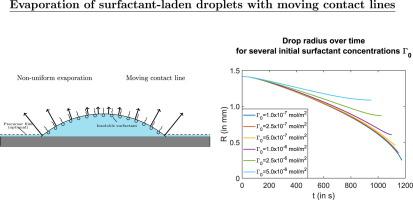Journal of Colloid and Interface Science ( IF 9.4 ) Pub Date : 2020-07-03 , DOI: 10.1016/j.jcis.2020.06.099 R T van Gaalen 1 , C Diddens 2 , H M A Wijshoff 3 , J G M Kuerten 1

|
Hypothesis
There are two different sharp-interface models for moving contact lines: slip models and precursor film models. While both models predict a mostly constant contact angle during the evaporation of pure droplets, it is expected that they behave differently when surfactants are present, because of the inherent dissimilarities in their respective interface definitions.
Simulations
Both contact line models are numerically implemented using lubrication theory to analyze evaporating droplets. A convection-diffusion equation is implemented for insoluble surfactants. For pure droplets the models are compared with experiments performed by Nguyen et al. (2012).
Findings
The two contact line models show results comparable to the experiments with pure droplets. If insoluble surfactants are present, the slip model increasingly shows pinning-like behavior as the initial surfactant concentration is increased. This ‘quasi-pinning’ is found to be consistent with experimental results in literature. The precursor film model, in contrast, shows no significant change when surfactants are added. This lack of change is a result of surfactant flowing from the droplet into the precursor film and vice versa. While suggesting potential solutions to this unphysical behavior, it is concluded that in the context of surfactants, slip models are preferable over precursor film models given the current state of the art.
中文翻译:

载有表面活性剂的液滴的蒸发:接触线模型之间的比较。
假设
对于移动接触线,有两种不同的敏锐接口模型:滑动模型和前体薄膜模型。虽然两个模型都预测纯液滴的蒸发过程中接触角基本恒定,但是由于存在各自的界面定义,因此预期当存在表面活性剂时它们的行为会有所不同。
模拟
两种接触线模型均使用润滑理论在数值上实现,以分析蒸发液滴。对不溶性表面活性剂实施对流扩散方程。对于纯液滴,将模型与Nguyen等人进行的实验进行比较。(2012)。
发现
两种接触线模型显示的结果与纯液滴实验相当。如果存在不溶性表面活性剂,则随着初始表面活性剂浓度的增加,滑模会越来越显示出类似钉扎的行为。发现这种“准固定”与文献中的实验结果一致。相反,当添加表面活性剂时,前体膜模型没有显示出显着变化。这种变化的缺乏是表面活性剂从液滴流入前体膜的结果,反之亦然。尽管提出了解决这种非物理行为的潜在解决方案,但得出的结论是,在表面活性剂的情况下,考虑到当前的技术水平,滑移模型优于前体膜模型。











































 京公网安备 11010802027423号
京公网安备 11010802027423号